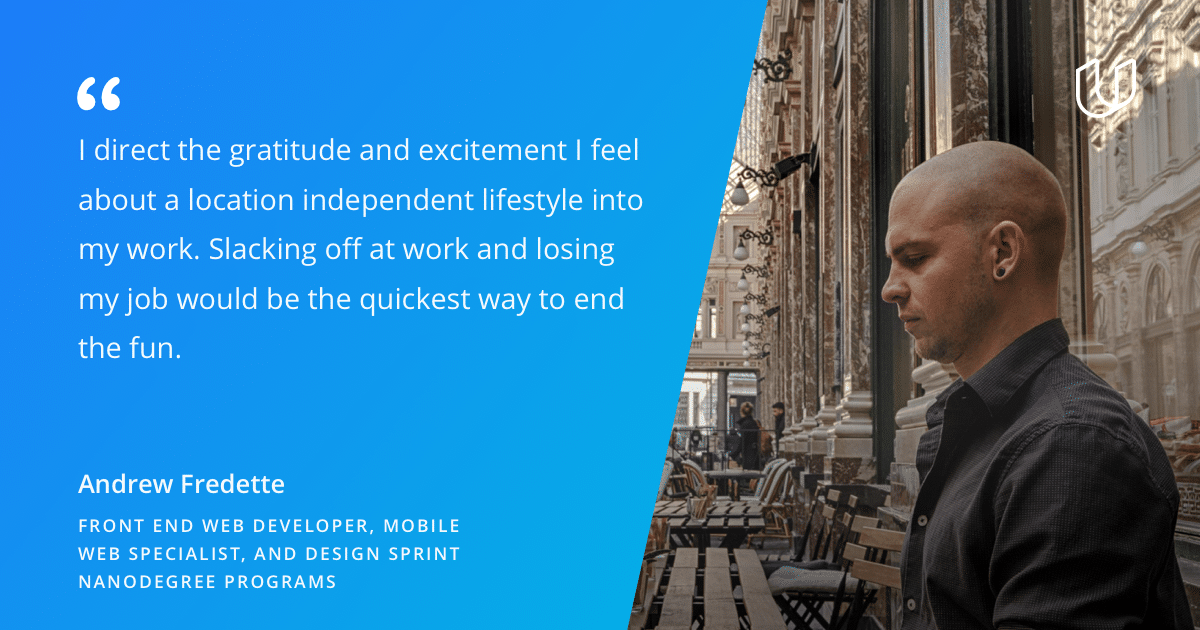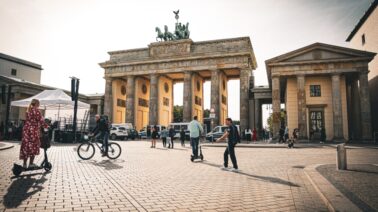Meet Andrew, a graduate of Udacity’s Front End Web Developer, Mobile Web Specialist, and Design Sprint Nanodegree programs. In 2018 he won a full Grow with Google scholarship in the Mobile Web Specialist track. He works full time remotely as a Front End Developer for a small company called Kynectiv, which helps clients implement simulation-based training. When he’s not programming, he runs a mastermind network for high-performers and blogs about personal development and travel. He’s a full-time digital nomad, based in Chiang Mai, Thailand at the time of this interview. We caught up with Andrew to learn more about this nomadic life and to answer the most common questions that he gets about his lifestyle.

What’s your travel schedule like as a digital nomad?
I like to really get to know a place when I travel! For two to six months I pick a “home base” and use it as a launching point to explore a region. I also think about what skills an area is best known for, and I’ll practice some of them for as long as I’m based there. For example, while I’m in Thailand I’m practicing Muay Thai, Buddhist meditation and Thai cooking. These learning “challenges” feed my curiosity and stretch my comfort zone. Taking these skills with me for the rest of my life is far more valuable to me than any souvenir.
This pace lets me get into more of a routine more easily than constantly moving around. But sometimes there’s just so many amazing things to see, and I’ll jump around to a new location every couple weeks. This can be a lot of fun, especially with friends, but is not very sustainable while balancing work and ongoing education.
View this post on Instagram
How did you find a full-time job compatible with nomad life?
Working remotely and becoming a digital nomad was very intentional for me. I distinctly remember the moment I committed to this plan: I was on the bus commuting home from an uninspired office job. I was reading Tim Ferriss’s 4 Hour Work Week when it clicked, I could be a programmer and travel the world! I remember the feeling of excitement and determination in making this plan a reality. Looking around the bus, I noticed the grim faces of the other commuters. I promised myself that I would find a way to live with more excitement and freedom than the typical 9-5 life.
From this moment, it took me about a year to land the remote job that changed my life. Honing my skills and finding the right job took a lot of effort, but it was well worth the journey. My keys to success were identifying and developing the right skill set (for me that was front end development via the Front End Nanodegree Program) and networking. Networking was extremely important, as the best jobs with small companies won’t be found on popular job boards, and will rely heavily on personal recommendations.
I anticipated all of the logistical concerns that my boss would have about me being halfway across the world and developed plans for them before beginning the conversation. I researched internet accessibility and developed a plan for my working hours to account for the time difference.
After landing the job, I worked very hard and built trusting relationships with my colleagues. Eventually, I started taking small trips, always making sure I did a better-than-average job when I was traveling. These trips gradually got longer and longer. By the time I was ready to float the idea of working from France or Thailand, I was confident that there would be no concerns.
Landing the perfect job is not an easy process but the payout is huge. If anyone would like more details on how I did this, I put together a PDF on my website (www.nomadicdrew.com) that outlines the steps I took. If there are enough requests, I’d be happy to put together some more in-depth videos. I’d like to help as many aspiring nomads as possible reach their goal; I think it’s great for building global community, and individual happiness and development!
Did the company already have remote employees?
The entire company works remotely. This was a major criterion for potential employers while I was job hunting. I knew that the transition from working at home to working anywhere in the world was a much smaller jump than going from office worker to digital nomad. For anyone that wants to become a digital nomad, I would strongly recommend limiting your search to fully remote positions (especially since they are becoming more common).
Let’s talk more about getting buy-in from your employer. How did you start the conversation around this idea/lifestyle started with your company?
Before I started the conversation, I recognized that there were a few essential keys to making sure that the conversation went well. I developed great relationships, trust, and a reputation of going above and beyond on all projects. Over the course of a couple of years, I would also take progressively larger trips, traveling around various parts of the US and Europe, while still doing an incredible job. I eventually did a two-month housesit in Canada to get them comfortable with me being international and being based in a foreign location for an extended period of time. By the time I was ready to start the conversation, I already was confident that the outcome would be favorable based on work that I had done.
When it was time to start the conversation, it was simple. I scheduled a meeting with our CEO and told him that I wanted to go to Asia for 4 months. I anticipated all of his concerns, time difference and the possible need for in-person meetings in the US. I had a plan for all of his concerns, so he was very comfortable with my travels and actually encouraged them!
View this post on Instagram
What kind of conversations did you have with your boss?
I anticipated all of the logistical concerns that my boss would have about me being halfway across the world and developed plans for them before beginning the conversation. I researched internet accessibility and developed a plan for my working hours to account for the time difference. These took care of the two biggest concerns they had. Although probably unnecessary, I also assured them that I would continue working very hard. I explained how grateful I am to have this lifestyle, and I know that it’s only possible by doing the work that enables it. My focus wouldn’t be completely swept away by the endless distractions that traveling offers.
How did you build the necessary trust with your colleagues to embark on this adventure?
I aggressively took on new projects and continued advancing my developer and small business skills. When they needed a volunteer for a new assignment, I was the first to raise my digital hand. I learned new programming skills and helped developed features. I made deadlines, took initiative and communicated well. I developed a reputation as someone very dependable no matter where I was located. To summarize, I CRUSHED it 🙂
How do you get things done with all the distractions?
There’s a simple idea that I hold onto that keeps my priorities aligned:
“The work I do enables the lifestyle I love.”
I direct the gratitude and excitement I feel about a location independent lifestyle into my work. This really helps me keep things in perspective and maintain a healthy balance of adventure and productivity. Slacking off at work and losing my job would be the quickest way to end the fun.
Other key ingredients are routine, accountability, and goals. It’s important to develop routines as quickly as possible for “normal” days. This allows you to get into a flow without much extra thought. External accountability with co-workers and close friends (I rely heavily on my mastermind group for this) is also vital. Often, it’s much more difficult for us to let others down than ourselves. Lastly, setting clear goals for the next few years adds more clarity and urgency to immediate tasks.
View this post on Instagram
How do you meet people when you travel?
Like any good millennial and software developer, I leverage technology. There’s an army of apps that help you meet new friends. Couchsurfers and Meetup.com are two of the best. There are several digital nomad-focused sites that are great, such as workfrom.com.
The convenience of technology is great, but my favorite interactions come from meeting people “in the wild.” Local events, meetups, gyms, and co-working spaces are some of my favorite hangouts. Hostel bars are great in a pinch. The best practice is just to get comfortable talking to anyone and everyone. Get used to meeting people while you’re on the move. It’s not always easy, but traveling alone will force you to get better at meeting people and making friends.
Don’t you get lonely and miss your friends and family?
Of course, there are some lonely times, but this is a small price to pay for the opportunity to explore the world. I try to use any loneliness as motivation to get out there and meet some amazing people.
When I miss my friends and family, I remind myself that I’m building a global network. It’s also so, so much fun when friends come out and meet you on your travels or you visit a friend in a remote part of the world. Actually, as I write this, I’m waiting for a plane to Singapore where I’ll be meeting a friend that I haven’t seen in two years. Stoked!
If you’d like to follow Andrew on his travels as a digital nomad, check out his Instagram, @nomadic_drew and his blog, www.nomadicdrew.com. If you have any more questions about nomadic life, Andrew invites you to reach out via Instagram DM. You can also follow along with Andrew’s travels as he shares updates on Udacity’s Instagram account and with the hashtag #WhereintheWorldisAndrew.



